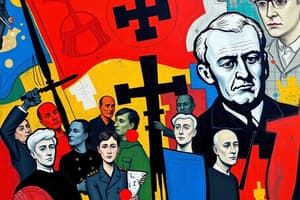Podcast
Questions and Answers
Which naval battle significantly shifted the balance of power in the Pacific during World War II?
Which naval battle significantly shifted the balance of power in the Pacific during World War II?
- Battle of Leyte Gulf
- Battle of Midway (correct)
- Battle of the Coral Sea
- Battle of Guadalcanal
What was a direct consequence of the atomic bombings of Hiroshima and Nagasaki?
What was a direct consequence of the atomic bombings of Hiroshima and Nagasaki?
- Japan's unconditional surrender (correct)
- The immediate occupation of Japan by Allied forces
- Germany's unconditional surrender
- The formation of the European Union
Which international organization was established in the aftermath of World War II to prevent future conflicts?
Which international organization was established in the aftermath of World War II to prevent future conflicts?
- World Trade Organization (WTO)
- North Atlantic Treaty Organization (NATO)
- League of Nations
- The United Nations (correct)
Besides Jewish people, which other group was systematically persecuted and murdered during the Holocaust?
Besides Jewish people, which other group was systematically persecuted and murdered during the Holocaust?
What was a significant long-term consequence of World War II on the global political landscape?
What was a significant long-term consequence of World War II on the global political landscape?
Which treaty, following World War I, is considered a contributing factor to the onset of World War II due to its harsh penalties on Germany?
Which treaty, following World War I, is considered a contributing factor to the onset of World War II due to its harsh penalties on Germany?
Which of the following best describes the nature of resource allocation during World War II?
Which of the following best describes the nature of resource allocation during World War II?
Which of the following was NOT a primary member of the Allied powers during World War II?
Which of the following was NOT a primary member of the Allied powers during World War II?
Which major theater of World War II was primarily fought between Japan and the United States, with other Allied countries also involved?
Which major theater of World War II was primarily fought between Japan and the United States, with other Allied countries also involved?
What marked the start of the liberation of Western Europe and a significant weakening of Nazi Germany?
What marked the start of the liberation of Western Europe and a significant weakening of Nazi Germany?
The Battle of Stalingrad represents a significant turning point in which major conflict zone of World War II?
The Battle of Stalingrad represents a significant turning point in which major conflict zone of World War II?
Which of the following was a characteristic of the totalitarian regimes that rose during the pre-WWII period?
Which of the following was a characteristic of the totalitarian regimes that rose during the pre-WWII period?
Which of these is an example of a major World War II campaign in the Pacific Theater?
Which of these is an example of a major World War II campaign in the Pacific Theater?
Flashcards
Battle of Midway
Battle of Midway
A decisive naval battle in the Pacific Ocean where the United States inflicted heavy losses on the Japanese Navy, shifting the balance of power in the Pacific.
The Holocaust
The Holocaust
The systematic and state-sponsored genocide of approximately six million European Jews during World War II.
Atomic Bombings of Japan
Atomic Bombings of Japan
The use of atomic bombs on Hiroshima and Nagasaki, Japan, which forced their unconditional surrender and ended World War II.
United Nations (UN)
United Nations (UN)
Signup and view all the flashcards
Technological Advancements in Warfare
Technological Advancements in Warfare
Signup and view all the flashcards
Treaty of Versailles's impact
Treaty of Versailles's impact
Signup and view all the flashcards
Rise of totalitarianism
Rise of totalitarianism
Signup and view all the flashcards
Economic depression's role
Economic depression's role
Signup and view all the flashcards
Failure of diplomacy
Failure of diplomacy
Signup and view all the flashcards
Axis powers
Axis powers
Signup and view all the flashcards
Allied powers
Allied powers
Signup and view all the flashcards
European Theater
European Theater
Signup and view all the flashcards
Pacific Theater
Pacific Theater
Signup and view all the flashcards
Study Notes
Introduction
- World War II, a global war from 1939 to 1945, involved most world countries and powerful nations.
- Two opposing military alliances, Allies and Axis, emerged.
- War effort consumed all economic, industrial, and scientific resources, blurring the civilian/military distinction.
- Unprecedented destruction and loss of life resulted, marking a turning point in human history.
Causes of World War II
- Treaty of Versailles' harsh penalties on Germany fostered resentment and instability.
- Rise of totalitarian regimes, like Nazi Germany under Hitler, promoted expansionist policies and aggressive nationalism.
- The Great Depression's economic downturn destabilized nations, making them susceptible to extremist ideologies.
- Lack of diplomatic conflict resolution enabled aggressive nations to exploit the global situation.
Key Players and Alliances
- Axis Powers: Germany, Italy, and Japan formed the primary Axis alliance.
- Allied Powers: France, the United Kingdom, the Soviet Union, and the United States, joined later by other nations, unified war aims and resources with agreements & declarations.
Major Theaters of War
- European Theater: Focused on Germany and its allies versus France, the UK, and the Soviet Union. Key battles included Blitzkrieg, the Battle of Britain, and the Eastern Front.
- Pacific Theater: Conflict between Japan and primarily the US, involving other Allied nations. Key battles were Pearl Harbor, the Battle of Midway, and the island-hopping campaign for Pacific island retaking.
Key Turning Points
- Battle of Stalingrad: Crucial Eastern Front turning point, major German defeat, beginning Soviet advance.
- D-Day: Allied Normandy invasion in 1944, liberation of Western Europe, significant Nazi weakening.
- Battle of Midway: Decisive naval battle in the Pacific neutralizing Japanese Navy, shifting Pacific power balance.
- Atomic bombings of Hiroshima and Nagasaki: Japan's forced unconditional surrender, ending the war.
Aftermath and Impact
- Millions died in World War II, with civilian losses often exceeding military.
- Millions were displaced, requiring rebuilding.
- The United Nations emerged, aimed at preventing future conflicts.
- Germany and Japan suffered substantial destruction and governmental changes.
- The Soviet Union became a prominent superpower, drastically altering the global political landscape.
- Advanced weaponry & technologies significantly impacted military strategies and numerous fields.
The Holocaust
- Nazi Germany systematically murdered approximately six million European Jews during WWII, a state-sponsored genocide.
- Persecution and murder of other groups, including homosexuals, Roma, disabled people, and political opponents, were part of the Holocaust.
- The Holocaust was a significant catalyst, highlighting the human cost of war.
- The systematic atrocities serve as a stark reminder of the importance of preventing future genocides.
Conclusion
- World War II reshaped the global political order, and its consequences impact international relations today.
- Unprecedented destruction, loss of life, and ideological conflicts occurred during WWII.
- Lessons learned from the war remain relevant in the 21st century.
Studying That Suits You
Use AI to generate personalized quizzes and flashcards to suit your learning preferences.
Description
This quiz explores the key events and forces that led to World War II, including the Treaty of Versailles, economic factors, and the rise of totalitarian regimes. Test your knowledge about how these elements contributed to one of history's most significant conflicts. Prepare to dive deep into the causes that reshaped the world.




